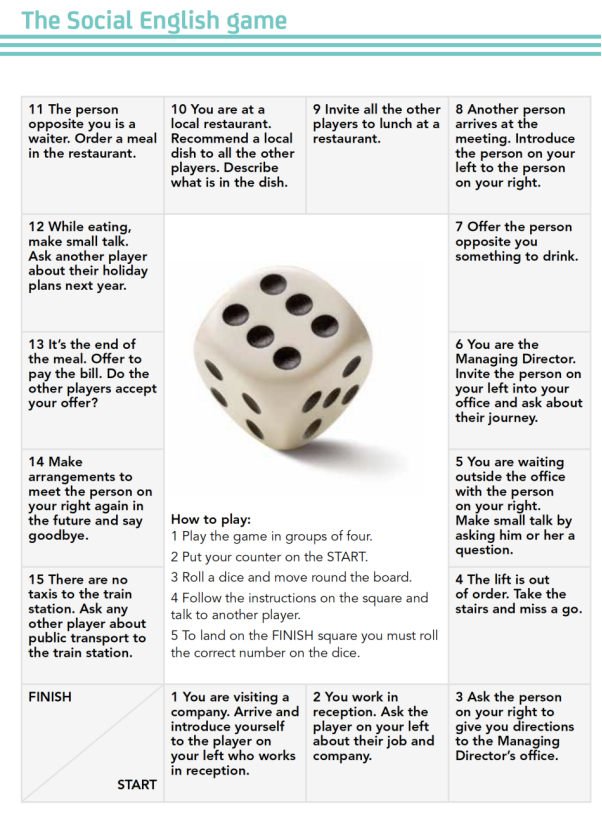Fluency Activities for Small Talk in Business English
John Hughes is a teacher trainer and author. With over 100 ELT titles, his Business English books include the Business Result series, Successful Meetings and Successful Presentations (Oxford University Press), Success with Business (National Geographic Learning), and ETpedia Business English (Pavilion ELT). He currently runs an online course in materials writing for teachers at www.writingeltmaterials.com. He has also written on a range of other subjects including theatre, sustainability and travel. Email: john@hugheselt.com

Editorial
This article is adapted from a unit in the book ‘ETpedia Business English’ by John Hughes and Robert McLarty, published by Pavilion ELT. The book won the David Riley Award for Innovation in Business Materials, awarded by the IATEFL Business English Special Interest Group.
Special Offer
You can purchase a copy of the book from https://pavpub.com/pavilion-elt/etpedia-series/etpedia-business-english?srsltid=AfmBOopHhNs5abSubEsWilOB0jb60ux6e-0M3IS9FA4TF4LSEScfDfpB
Use the discount code etpediabe for a 30% discount on all books in the ETpedia series. The code remains valid until December 31st, 2025.
The thinking behind the activities
You may have come across students who say to you, “I don’t need English for my job. I already know how to talk about business. Instead, I need help with making conversation and talking about general topics in English.” This might well be true, but the English these types of students describe is still a type of business English. It’s ‘Social English’, or ‘English for Small Talk’. It’s the English they need at conferences, to build customer relationships, or maybe to start conversations when cold calling. It means that they need plenty of time for developing their fluency and building confidence with the skill of networking.
Here are some activities that focus on this skill area. The first four activities work on question forms so that students practise showing interest in the other speaker(s). Activities 5, 6 and 7 offer the chance to talk about different topics and use a range of vocabulary as well consider the skills needed to build conversations. Activity 8 offers a fun board games activity which ties together a variety of social and small talk situations
1. First day small talk
This simple activity is for the first day with a new class and practises basic question forms for making conversation with a new person. Invite students to ask you questions and write them on the board, e.g. Where are you from? How long have you worked as a …? Write around 10 on the board and then answer them. Next, put students in pairs and ask them to take turns asking and answering the questions on the board so they find out about each other.
2. Guess the question
Another activity that is useful for students to get to know each other on a business course and also practise the language for making conversations is to ask students to think of five important facts about their life and to write down one word associated with each. So if it’s the city they are from, they can write it down. The word can also be something less obvious like the number of years they have worked for their current company (so they might write a number such as ‘10’ meaning 10 years). Next, put the students in pairs. The students show each other their list of five words and take turns to guess the question the word will answer; for example, Where are you from? or How long have you worked for your current company? The winner is the student who guesses the questions for all five words.
3. Dice questions
The aim of this activity is to practise question forms to make small talk about different topics. You will need some dice. Students work in pairs and with two dice per pair. Write the following dice numbers (1-6) on the board:
Topics: 1 = sports and hobbies, 2= travel and holidays, 3 = work, 4 = news and media, 5 =
family and friends, 6 = weather Questions: 1 = what, 2 = where, 3 = how, 4 = when, 5 = which, 6 = why
Students take turns to roll the two dice. One dice is for topics so if it lands on 4, the students must create a question about ‘news and media’. The other dice indicates the question word they must use, so if it lands on 5, they must start their question with ‘Which’. So the student who rolled can ask a question such as ‘Which newspaper do you normally read?’ and the other student must answer. It requires quick-thinking and generates a whole range of question types.
4. Developing open questions
Effective conversationalists tend to build small talk by asking a closed question (one that can be answered with a simple ‘yes’ or ‘no’) followed by an open question starting with what, why, how, where etc. For example:
A: Is this your first time at this conference?
B: Yes, it is.
A: How are you finding it?
B: Great, thanks. It’s been really interesting so far.
Students can develop this skill with the following activity which is also a useful way
to practise and revise the language of question forms. Write a list of general Yes/No
questions on the board such as:
1. Do you play much sport?
2. Do you like Italian food?
3. Are you from Sweden?
4. Do you often travel for your job?
5. Is this your first time at this conference?
Next, put students into A/B pairs. A begins by asking B one of the Yes/No questions on the board and B replies with a Yes/No answer. Then A must create a follow-up question which is open and B must reply. Then they switch roles and repeat the activity with a different question. Continue until they have used all the questions on the board.
5. One-minute topics
A simple fluency warmer for a lesson is to have a box full of pieces of paper with different topics to talk about. These could include general topic headings such as ‘sport’ or ‘films’ or more specific headings such as ‘your favourite day of the year’ or ‘the least interesting aspect of your job’. Students work in pairs and take turns to pick a piece of paper out of the box. They have one minute to talk about the topic while their partner times them. If they manage to speak non-stop for a minute they get a point. Then they swap roles and the other student has a go. You can update the topics in the box from time-to-time with new topics; in fact, if you choose topic areas recently covered in class then it’s a good way to revise recently taught language.
6. Common topics
Many business networking conversations centre around finding things you have common with the other person. To practise this skill and the language required, put students into groups of four or five. Write a selection of small talk topics randomly on the board such sport, family, travel, food, politics, films, music, money, holidays, pets, weather. Next, explain that they are at a networking event and they have five minutes to make conversation about any of the topics on the board. The aim is to find as many commonalities as possible with the other people in the group. For example, a conversation might go like this:
A: Have any of you ever visited New York?
B: No, I haven’t.
C: Yes, I went there last year.
A: Really? I was there last year as well…
Every time a student finds something they have in common with another person in the
group they give themselves a point. So for the conversation above, A and C both get a
point for having both been to New York whereas B does not. The strategy to gaining the
most points in this activity is to introduce as many varied topics as possible to try and find commonalities with other people in the group. The competitive element mixed with fun and rivalry makes it great fluency practice and really helps to develop networking skills. (This activity is based on idea from Daniel Pink’s excellent book To sell is human, published by Canongate, 2012.)
7. Taboo topics
This is a variation on the previous activity which focuses students’ attention on cultural differences and strategies for avoiding talking about certain topics. As with the previous activity, students work in small groups and you need to write a variety of topics for small talk on the board like this: sport, family, religion, travel, food, politics, films, music, salaries, holidays, pets, weather.
Explain to the students that in certain cultures it isn’t appropriate to discuss certain topics; for example, some cultures will not talk about topics such as salaries or religion. Tell each student to choose two topics off the board which they will not talk about. These don’t have to be real cultural choices, but random such as ‘films’ and ‘weather’.
Next, tell students that they have five minutes to make small talk with each other about the topics on the board. In that time, each student must try to work out which two topics are taboo for each of the speakers. This requires students to try and introduce each of the topics into the conversation in order to establish which students are avoiding them. At the end of the five minutes, the students tell each other which topics they think each other chose.
It’s a fun activity that raises their awareness of how culture can affect conversation and also practises a range of social English skills.
8. Social English board game
To finish off with, here’s a board game for practising language in social situations. Make one copy of the photocopiable board below for pairs of students or groups of three. They will need a dice and each player needs a counter (a coin, for example) and places it on the START square. They take turns to roll the dice and move their counter round the board. As they land on each square, they follow the instructions and practise speaking in a range of social situations.

Coming soon! Please check the Pilgrims in Segovia Teacher Training courses 2026 at Pilgrims website
Teaching Business English: Paths and Possibilities
Jelena Perišić, Serbia50 Ways to Teach Business English, Tips for ESL/EFL Teachers
Marjorie Rosenberg, AustriaFluency Activities for Small Talk in Business English
John Hughes, UKWriting Materials for Business English
John Hughes, UK10 ideas from ETpedia Business English from Pavilion
One-to-One: An Updated and Practical Guide to Teaching. A New Addition to Your CPD Collection
review by Oksana Hera, UkraineBusiness Impact. Business English Modules from DELTA Publishing, with a Short Review, by Hanna Kryszewska, Poland
Hanna Kryszewska, PolandA Golden Classic: Tree Swing Cartoons
Hanna Kryszewska, Poland